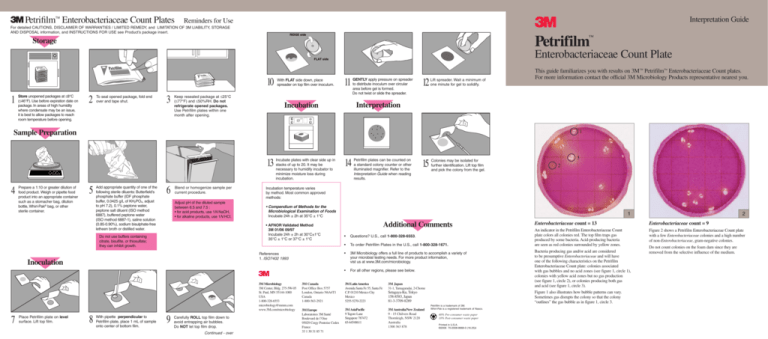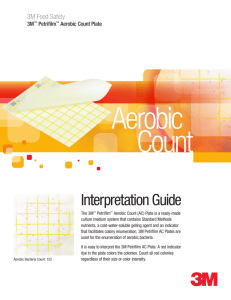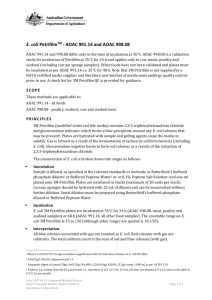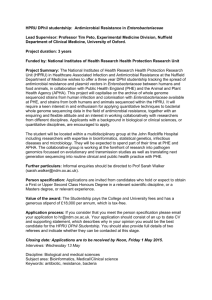3M Petrifilm Enterobacteriaceae Count Plate Guide
advertisement

3Petrifilm™ Enterobacteriaceae Count Plates 3 Petrifilm Reminders for Use For detailed CAUTIONS, DISCLAIMER OF WARRANTIES / LIMITED REMEDY, and LIMITATION OF 3M LIABILITY, STORAGE AND DISPOSAL information, and INSTRUCTIONS FOR USE see Product’s package insert. RIDGE side ™ Storage Enterobacteriaceae Count Plate FLAT side Petrifilm Petrifilm Petrifilm 10 1 Store unopened packages at ≤8°C (≤46°F). Use before expiration date on package. In areas of high humidity where condensate may be an issue, it is best to allow packages to reach room temperature before opening. 2 To seal opened package, fold end over and tape shut. 3 Keep resealed package at ≤25°C (≤77°F) and ≤50%RH. Do not refrigerate opened packages. Use Petrifilm plates within one month after opening. With FLAT side down, place spreader on top film over inoculum. 11 GENTLY apply pressure on spreader to distribute inoculum over circular area before gel is formed. Do not twist or slide the spreader. 12 Lift spreader. Wait a minimum of one minute for gel to solidify. This guide familiarizes you with results on 3M™ Petrifilm™ Enterobacteriaceae Count plates. For more information contact the official 3M Microbiology Products representative nearest you. Interpretation Incubation <70°F Sample Preparation 1 13 4 Prepare a 1:10 or greater dilution of food product. Weigh or pipette food product into an appropriate container such as a stomacher bag, dilution bottle, Whirl-Pak® bag, or other sterile container. 5 Add appropriate quantity of one of the following sterile diluents: Butterfield's phosphate buffer (IDF phosphate buffer, 0.0425 g/L of KH2PO4, adjust to pH 7.2), 0.1% peptone water, peptone salt diluent (ISO method 6887), buffered peptone water (ISO method 6887-1), saline solution (0.85-0.90%), sodium bisulphate-free letheen broth or distilled water. 6 Blend or homogenize sample per current procedure. Adjust pH of the diluted sample between 6.5 and 7.5 : • for acid products, use 1N NaOH, • for alkaline products, use 1N HCI. Incubate plates with clear side up in stacks of up to 20. It may be necessary to humidify incubator to minimize moisture loss during incubation. Inoculation 7 8 9 Carefully ROLL top film down to avoid entrapping air bubbles. Do NOT let top film drop. Continued - over 15 Colonies may be isolated for further identification. Lift top film and pick the colony from the gel. 3 2 • Compendium of Methods for the Microbiological Examination of Foods Incubate 24h ± 2h at 35°C ± 1°C 22 1 Additional Comments • Questions? U.S., call 1-800-328-6553. • To order Petrifilm Plates in the U.S., call 1-800-328-1671. References 1. ISO7402 1993 • 3M Microbiology offers a full line of products to accomplish a variety of your microbial testing needs. For more product information, vist us at www.3M.com/microbiology. 3 • For all other regions, please see below. 3M Microbiology 3M Center, Bldg. 275-5W-05 St. Paul, MN 55144-1000 USA 1-800-328-6553 microbiology@mmm.com www.3M.com/microbiology With pipette perpendicular to Petrifilm plate, place 1 mL of sample onto center of bottom film. 14 Petrifilm plates can be counted on a standard colony counter or other illuminated magnifier. Refer to the Interpretation Guide when reading results. Incubation temperature varies by method. Most common approved methods: • AFNOR Validated Method 3M 01/06 09/97 Incubate 24h ± 2h at 30°C±1°C 35°C ± 1°C or 37°C ± 1°C Do not use buffers containing citrate, bisulfite, or thiosulfate; they can inhibit growth. Place Petrifilm plate on level surface. Lift top film. Interpretation Guide 3M Canada Post Office Box 5757 London, Ontario N6A4T1 Canada 1-800-563-2921 3M Latin America Avenida Santa Fe 55, Santa Fe C.P. 01210 Mexico City Mexico 5255-5270-2223 3M Japan 31-1, Tamagaradai, 2-Chome 3M Europe Laboratoires 3M Santé Boulevard de l’Oise 95029 Cergy Pontoise Cedex France 33 1 30 31 85 71 3M AsiaPacific 9 Tagore Lane Singapore 787472 65-64548611 3M Australia/New Zealand 9 - 15 Chilvers Road Thornleigh, NSW 2120 Australia 1300 363 878 Enterobacteriaceae count = 13 Enterobacteriaceae count = 9 An indicator in the Petrifilm Enterobacteriaceae Count plate colors all colonies red. The top film traps gas produced by some bacteria. Acid-producing bacteria are seen as red colonies surrounded by yellow zones. Figure 2 shows a Petrifilm Enterobacteriaceae Count plate with a few Enterobacteriaceae colonies and a high number of non-Enterobacteriaceae, gram-negative colonies. Bacteria producing gas and/or acid are considered to be presumptive Enterobacteriaceae and will have one of the following characteristics on the Petrifilm Enterobacteriaceae Count plate: colonies associated with gas bubbles and no acid zones (see figure 1, circle 1), colonies with yellow acid zones but no gas production (see figure 1, circle 2), or colonies producing both gas and acid (see figure 1, circle 3). Figure 1 also illustrates how bubble patterns can vary. Sometimes gas disrupts the colony so that the colony “outlines” the gas bubble as in figure 1, circle 3. Setagaya-Ku, Tokyo 158-8583, Japan 81-3-3709-8289 Petrifilm is a trademark of 3M. Whirl-Pak is a registered trademark of Nasco. 40% Pre-consumer waste paper 10% Post-consumer waste paper Printed in U.S.A. ©2006 70-2008-8668-0 (16.25)ii Do not count colonies on the foam dam since they are removed from the selective influence of the medium. 3M Petrifilm ™ ™ TNTC (Too Numerous to Count) To obtain a more accurate count, dilute the sample further. Enterobacteriaceae Count Plate 3 Enterobacteriaceae count = 0 4 Enterobacteriaceae count = 35 Notice the change in gel color in figures 3 through 8. As the Enterobacteriaceae count increases, the color of the gel lightens from purple to yellow or cream colored. 5 6 Artifact Bubbles and Food Particles Do Not Enumerate 10 10 9 7 Enterobacteriaceae count = TNTC Enterobacteriaceae count = TNTC Enterobacteriaceae count = 44 Enterobacteriaceae count = 2 Petrifilm Enterobacteriaceae Count plates with more than 100 colonies are considered too numerous to count (TNTC) and have a light background color along with at least one of the following characteristics: many small colonies or many gas bubbles. See figure 6. In figure 7, the count is so high that acid zones and gas bubbles are not easily seen. A lightening of the gel color indicates that the result is TNTC. Artifact bubbles may result from improper inoculation of the Petrifilm Enterobacteriaceae Count plate. They are irregularly shaped and not associated with a red colony. See figure 9. Food particles are often irregularly shaped or filamentous and are not associated with gas bubbles or acid zones. See figure 10. Enterobacteriaceae count = 77 Enterobacteriaceae count = TNTC Enterobacteriaceae count = 29 The recommended counting range on Petrifilm Enterobacteriaceae Count plates is 15–100 colonies. Samples having counts greater than 100 Enterobacteriaceae per plate may be estimated. The circular growth area is approximately 20 cm2. Estimates can be made by counting the number of colonies in one or more representative squares and determining the average number per square. Multiply the average number of colonies per square by 20 to determine the estimated count per plate. The Petrifilm Enterobacteriaceae Count plate in figure 8 has two characteristics indicating TNTC colonies: lightening of the gel color and many small colonies. Food particles also can be seen as dark spots but are not associated with gas bubbles or acid zones. See figure 11. 8 11 3M Petrifilm ™ ™ TNTC (Too Numerous to Count) To obtain a more accurate count, dilute the sample further. Enterobacteriaceae Count Plate 3 Enterobacteriaceae count = 0 4 Enterobacteriaceae count = 35 Notice the change in gel color in figures 3 through 8. As the Enterobacteriaceae count increases, the color of the gel lightens from purple to yellow or cream colored. 5 6 Artifact Bubbles and Food Particles Do Not Enumerate 10 10 9 7 Enterobacteriaceae count = TNTC Enterobacteriaceae count = TNTC Enterobacteriaceae count = 44 Enterobacteriaceae count = 2 Petrifilm Enterobacteriaceae Count plates with more than 100 colonies are considered too numerous to count (TNTC) and have a light background color along with at least one of the following characteristics: many small colonies or many gas bubbles. See figure 6. In figure 7, the count is so high that acid zones and gas bubbles are not easily seen. A lightening of the gel color indicates that the result is TNTC. Artifact bubbles may result from improper inoculation of the Petrifilm Enterobacteriaceae Count plate. They are irregularly shaped and not associated with a red colony. See figure 9. Food particles are often irregularly shaped or filamentous and are not associated with gas bubbles or acid zones. See figure 10. Enterobacteriaceae count = 77 Enterobacteriaceae count = TNTC Enterobacteriaceae count = 29 The recommended counting range on Petrifilm Enterobacteriaceae Count plates is 15–100 colonies. Samples having counts greater than 100 Enterobacteriaceae per plate may be estimated. The circular growth area is approximately 20 cm2. Estimates can be made by counting the number of colonies in one or more representative squares and determining the average number per square. Multiply the average number of colonies per square by 20 to determine the estimated count per plate. The Petrifilm Enterobacteriaceae Count plate in figure 8 has two characteristics indicating TNTC colonies: lightening of the gel color and many small colonies. Food particles also can be seen as dark spots but are not associated with gas bubbles or acid zones. See figure 11. 8 11 3M Petrifilm ™ ™ TNTC (Too Numerous to Count) To obtain a more accurate count, dilute the sample further. Enterobacteriaceae Count Plate 3 Enterobacteriaceae count = 0 4 Enterobacteriaceae count = 35 Notice the change in gel color in figures 3 through 8. As the Enterobacteriaceae count increases, the color of the gel lightens from purple to yellow or cream colored. 5 6 Artifact Bubbles and Food Particles Do Not Enumerate 10 10 9 7 Enterobacteriaceae count = TNTC Enterobacteriaceae count = TNTC Enterobacteriaceae count = 44 Enterobacteriaceae count = 2 Petrifilm Enterobacteriaceae Count plates with more than 100 colonies are considered too numerous to count (TNTC) and have a light background color along with at least one of the following characteristics: many small colonies or many gas bubbles. See figure 6. In figure 7, the count is so high that acid zones and gas bubbles are not easily seen. A lightening of the gel color indicates that the result is TNTC. Artifact bubbles may result from improper inoculation of the Petrifilm Enterobacteriaceae Count plate. They are irregularly shaped and not associated with a red colony. See figure 9. Food particles are often irregularly shaped or filamentous and are not associated with gas bubbles or acid zones. See figure 10. Enterobacteriaceae count = 77 Enterobacteriaceae count = TNTC Enterobacteriaceae count = 29 The recommended counting range on Petrifilm Enterobacteriaceae Count plates is 15–100 colonies. Samples having counts greater than 100 Enterobacteriaceae per plate may be estimated. The circular growth area is approximately 20 cm2. Estimates can be made by counting the number of colonies in one or more representative squares and determining the average number per square. Multiply the average number of colonies per square by 20 to determine the estimated count per plate. The Petrifilm Enterobacteriaceae Count plate in figure 8 has two characteristics indicating TNTC colonies: lightening of the gel color and many small colonies. Food particles also can be seen as dark spots but are not associated with gas bubbles or acid zones. See figure 11. 8 11 3Petrifilm™ Enterobacteriaceae Count Plates 3 Petrifilm Reminders for Use For detailed CAUTIONS, DISCLAIMER OF WARRANTIES / LIMITED REMEDY, and LIMITATION OF 3M LIABILITY, STORAGE AND DISPOSAL information, and INSTRUCTIONS FOR USE see Product’s package insert. RIDGE side ™ Storage Enterobacteriaceae Count Plate FLAT side Petrifilm Petrifilm Petrifilm 10 1 Store unopened packages at ≤8°C (≤46°F). Use before expiration date on package. In areas of high humidity where condensate may be an issue, it is best to allow packages to reach room temperature before opening. 2 To seal opened package, fold end over and tape shut. 3 Keep resealed package at ≤25°C (≤77°F) and ≤50%RH. Do not refrigerate opened packages. Use Petrifilm plates within one month after opening. With FLAT side down, place spreader on top film over inoculum. 11 GENTLY apply pressure on spreader to distribute inoculum over circular area before gel is formed. Do not twist or slide the spreader. 12 Lift spreader. Wait a minimum of one minute for gel to solidify. This guide familiarizes you with results on 3M™ Petrifilm™ Enterobacteriaceae Count plates. For more information contact the official 3M Microbiology Products representative nearest you. Interpretation Incubation <70°F Sample Preparation 1 13 4 Prepare a 1:10 or greater dilution of food product. Weigh or pipette food product into an appropriate container such as a stomacher bag, dilution bottle, Whirl-Pak® bag, or other sterile container. 5 Add appropriate quantity of one of the following sterile diluents: Butterfield's phosphate buffer (IDF phosphate buffer, 0.0425 g/L of KH2PO4, adjust to pH 7.2), 0.1% peptone water, peptone salt diluent (ISO method 6887), buffered peptone water (ISO method 6887-1), saline solution (0.85-0.90%), sodium bisulphate-free letheen broth or distilled water. 6 Blend or homogenize sample per current procedure. Adjust pH of the diluted sample between 6.5 and 7.5 : • for acid products, use 1N NaOH, • for alkaline products, use 1N HCI. Incubate plates with clear side up in stacks of up to 20. It may be necessary to humidify incubator to minimize moisture loss during incubation. Inoculation 7 8 9 Carefully ROLL top film down to avoid entrapping air bubbles. Do NOT let top film drop. Continued - over 15 Colonies may be isolated for further identification. Lift top film and pick the colony from the gel. 3 2 • Compendium of Methods for the Microbiological Examination of Foods Incubate 24h ± 2h at 35°C ± 1°C 22 1 Additional Comments • Questions? U.S., call 1-800-328-6553. • To order Petrifilm Plates in the U.S., call 1-800-328-1671. References 1. ISO7402 1993 • 3M Microbiology offers a full line of products to accomplish a variety of your microbial testing needs. For more product information, vist us at www.3M.com/microbiology. 3 • For all other regions, please see below. 3M Microbiology 3M Center, Bldg. 275-5W-05 St. Paul, MN 55144-1000 USA 1-800-328-6553 microbiology@mmm.com www.3M.com/microbiology With pipette perpendicular to Petrifilm plate, place 1 mL of sample onto center of bottom film. 14 Petrifilm plates can be counted on a standard colony counter or other illuminated magnifier. Refer to the Interpretation Guide when reading results. Incubation temperature varies by method. Most common approved methods: • AFNOR Validated Method 3M 01/06 09/97 Incubate 24h ± 2h at 30°C±1°C 35°C ± 1°C or 37°C ± 1°C Do not use buffers containing citrate, bisulfite, or thiosulfate; they can inhibit growth. Place Petrifilm plate on level surface. Lift top film. Interpretation Guide 3M Canada Post Office Box 5757 London, Ontario N6A4T1 Canada 1-800-563-2921 3M Latin America Avenida Santa Fe 55, Santa Fe C.P. 01210 Mexico City Mexico 5255-5270-2223 3M Japan 31-1, Tamagaradai, 2-Chome 3M Europe Laboratoires 3M Santé Boulevard de l’Oise 95029 Cergy Pontoise Cedex France 33 1 30 31 85 71 3M AsiaPacific 9 Tagore Lane Singapore 787472 65-64548611 3M Australia/New Zealand 9 - 15 Chilvers Road Thornleigh, NSW 2120 Australia 1300 363 878 Enterobacteriaceae count = 13 Enterobacteriaceae count = 9 An indicator in the Petrifilm Enterobacteriaceae Count plate colors all colonies red. The top film traps gas produced by some bacteria. Acid-producing bacteria are seen as red colonies surrounded by yellow zones. Figure 2 shows a Petrifilm Enterobacteriaceae Count plate with a few Enterobacteriaceae colonies and a high number of non-Enterobacteriaceae, gram-negative colonies. Bacteria producing gas and/or acid are considered to be presumptive Enterobacteriaceae and will have one of the following characteristics on the Petrifilm Enterobacteriaceae Count plate: colonies associated with gas bubbles and no acid zones (see figure 1, circle 1), colonies with yellow acid zones but no gas production (see figure 1, circle 2), or colonies producing both gas and acid (see figure 1, circle 3). Figure 1 also illustrates how bubble patterns can vary. Sometimes gas disrupts the colony so that the colony “outlines” the gas bubble as in figure 1, circle 3. Setagaya-Ku, Tokyo 158-8583, Japan 81-3-3709-8289 Petrifilm is a trademark of 3M. Whirl-Pak is a registered trademark of Nasco. 40% Pre-consumer waste paper 10% Post-consumer waste paper Printed in U.S.A. ©2006 70-2008-8668-0 (16.25)ii Do not count colonies on the foam dam since they are removed from the selective influence of the medium. 3Petrifilm™ Enterobacteriaceae Count Plates 3 Petrifilm Reminders for Use For detailed CAUTIONS, DISCLAIMER OF WARRANTIES / LIMITED REMEDY, and LIMITATION OF 3M LIABILITY, STORAGE AND DISPOSAL information, and INSTRUCTIONS FOR USE see Product’s package insert. RIDGE side ™ Storage Enterobacteriaceae Count Plate FLAT side Petrifilm Petrifilm Petrifilm 10 1 Store unopened packages at ≤8°C (≤46°F). Use before expiration date on package. In areas of high humidity where condensate may be an issue, it is best to allow packages to reach room temperature before opening. 2 To seal opened package, fold end over and tape shut. 3 Keep resealed package at ≤25°C (≤77°F) and ≤50%RH. Do not refrigerate opened packages. Use Petrifilm plates within one month after opening. With FLAT side down, place spreader on top film over inoculum. 11 GENTLY apply pressure on spreader to distribute inoculum over circular area before gel is formed. Do not twist or slide the spreader. 12 Lift spreader. Wait a minimum of one minute for gel to solidify. This guide familiarizes you with results on 3M™ Petrifilm™ Enterobacteriaceae Count plates. For more information contact the official 3M Microbiology Products representative nearest you. Interpretation Incubation <70°F Sample Preparation 1 13 4 Prepare a 1:10 or greater dilution of food product. Weigh or pipette food product into an appropriate container such as a stomacher bag, dilution bottle, Whirl-Pak® bag, or other sterile container. 5 Add appropriate quantity of one of the following sterile diluents: Butterfield's phosphate buffer (IDF phosphate buffer, 0.0425 g/L of KH2PO4, adjust to pH 7.2), 0.1% peptone water, peptone salt diluent (ISO method 6887), buffered peptone water (ISO method 6887-1), saline solution (0.85-0.90%), sodium bisulphate-free letheen broth or distilled water. 6 Blend or homogenize sample per current procedure. Adjust pH of the diluted sample between 6.5 and 7.5 : • for acid products, use 1N NaOH, • for alkaline products, use 1N HCI. Incubate plates with clear side up in stacks of up to 20. It may be necessary to humidify incubator to minimize moisture loss during incubation. Inoculation 7 8 9 Carefully ROLL top film down to avoid entrapping air bubbles. Do NOT let top film drop. Continued - over 15 Colonies may be isolated for further identification. Lift top film and pick the colony from the gel. 3 2 • Compendium of Methods for the Microbiological Examination of Foods Incubate 24h ± 2h at 35°C ± 1°C 22 1 Additional Comments • Questions? U.S., call 1-800-328-6553. • To order Petrifilm Plates in the U.S., call 1-800-328-1671. References 1. ISO7402 1993 • 3M Microbiology offers a full line of products to accomplish a variety of your microbial testing needs. For more product information, vist us at www.3M.com/microbiology. 3 • For all other regions, please see below. 3M Microbiology 3M Center, Bldg. 275-5W-05 St. Paul, MN 55144-1000 USA 1-800-328-6553 microbiology@mmm.com www.3M.com/microbiology With pipette perpendicular to Petrifilm plate, place 1 mL of sample onto center of bottom film. 14 Petrifilm plates can be counted on a standard colony counter or other illuminated magnifier. Refer to the Interpretation Guide when reading results. Incubation temperature varies by method. Most common approved methods: • AFNOR Validated Method 3M 01/06 09/97 Incubate 24h ± 2h at 30°C±1°C 35°C ± 1°C or 37°C ± 1°C Do not use buffers containing citrate, bisulfite, or thiosulfate; they can inhibit growth. Place Petrifilm plate on level surface. Lift top film. Interpretation Guide 3M Canada Post Office Box 5757 London, Ontario N6A4T1 Canada 1-800-563-2921 3M Latin America Avenida Santa Fe 55, Santa Fe C.P. 01210 Mexico City Mexico 5255-5270-2223 3M Japan 31-1, Tamagaradai, 2-Chome 3M Europe Laboratoires 3M Santé Boulevard de l’Oise 95029 Cergy Pontoise Cedex France 33 1 30 31 85 71 3M AsiaPacific 9 Tagore Lane Singapore 787472 65-64548611 3M Australia/New Zealand 9 - 15 Chilvers Road Thornleigh, NSW 2120 Australia 1300 363 878 Enterobacteriaceae count = 13 Enterobacteriaceae count = 9 An indicator in the Petrifilm Enterobacteriaceae Count plate colors all colonies red. The top film traps gas produced by some bacteria. Acid-producing bacteria are seen as red colonies surrounded by yellow zones. Figure 2 shows a Petrifilm Enterobacteriaceae Count plate with a few Enterobacteriaceae colonies and a high number of non-Enterobacteriaceae, gram-negative colonies. Bacteria producing gas and/or acid are considered to be presumptive Enterobacteriaceae and will have one of the following characteristics on the Petrifilm Enterobacteriaceae Count plate: colonies associated with gas bubbles and no acid zones (see figure 1, circle 1), colonies with yellow acid zones but no gas production (see figure 1, circle 2), or colonies producing both gas and acid (see figure 1, circle 3). Figure 1 also illustrates how bubble patterns can vary. Sometimes gas disrupts the colony so that the colony “outlines” the gas bubble as in figure 1, circle 3. Setagaya-Ku, Tokyo 158-8583, Japan 81-3-3709-8289 Petrifilm is a trademark of 3M. Whirl-Pak is a registered trademark of Nasco. 40% Pre-consumer waste paper 10% Post-consumer waste paper Printed in U.S.A. ©2006 70-2008-8668-0 (16.25)ii Do not count colonies on the foam dam since they are removed from the selective influence of the medium.







